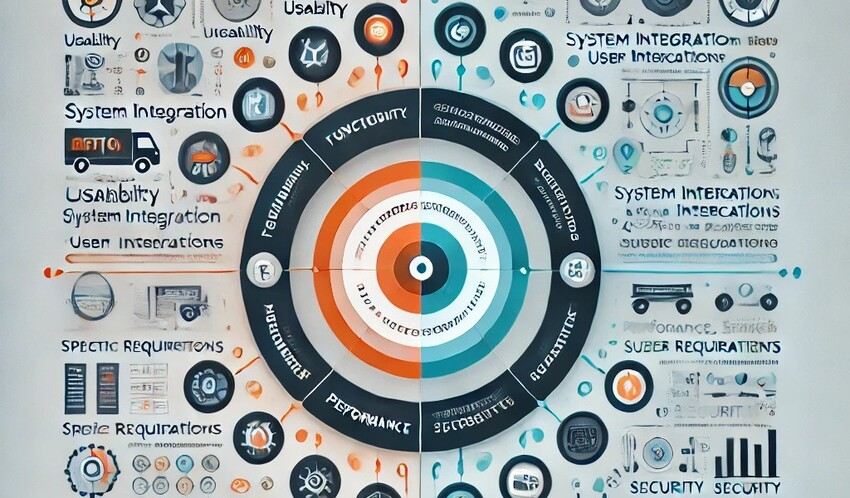Last updated on September 22nd, 2025 at 10:31 am
Software testing therefore is performed as an important phase of the software development cycle designed to check that software products conform to specified requirements and are performing as expected. However, in the ISTQB (International Software Testing Qualifications Board) syllabus, the notion of test conditions is used to describe a very important aspect of test case management. The Board also helps to define the model to systemize how a test should be performed and by doing so, facilitates the identification of not only functional but also non-functional requirements of the software.
In this article, I will propose the classification of test conditions in ISTQB, focusing on functional and non-functional examples. By doing so, testers will develop a sense of what it really means to apply these principles when testing computer systems and software.
Test condition in ISTQB: What Does It Mean?
In ISTQB terminology, a test condition refers to an item or event in a system that one or more test cases could verify. A test condition can technically be any part of the software, including a specific function or a large area of the system’s performance.
Configuration aspects in ISTQB are applied to creation test conditions by defining what will be done at the end of what, how it will be done, and under which circumstances. Testers make a plan indicating how important application components should be tested when presenting test conditions. The above-organized approach follows testing with much precision and makes it possible to eliminate common issues such as ambiguities or even missed requirements.
Types of Test Conditions in ISTQB
Broadly, there are two main categories of test conditions in ISTQB: structural and infrastructural and non-structural and infrastructural. These categories are oriented toward different aspects of software testing and concern the system’s performance under certain conditions.
Functional Test Conditions in ISTQB
Functional testing concentrates on understanding whether certain pieces of software meet the intended specifications. These test conditions remain specific to react as a guideline so that every system function shall operate in the most expected way. Functional test conditions can include:
Input and Output Validation
Besides, one of the most critical functional test conditions is the test for input and output. Some test cases are created to provoke the states mentioned earlier by checking that the software accepts only the input in the specified range and format, whereas it does not take other inputs. For instance, in the presence of an application that deals with finance clearly, the input to the application is a currency input, and a condition to check whether the apostrophe symbolizes the decimal place in the input is a functional test condition.
User Interface (UI) Behavior
It also includes the assessment of the responses or the activity of the interface while being in use. As such, this may consist of an evaluation of genres of buttons, forms, navigation, and any other interface elements that it will contain. Everyone ensures it responds to how the actual design intends it to.
Database Integrity
While testing conditions in ISTQB are commonly designed with interactions with the database, the aim is to test whether they are working as required. For instance, when a form is filled by a user which includes their full name (e.g., Charlie Mullins), it is expected that data pertaining the form should be registered in the database. In addition, the system should accurately search for, modify and delete records as may be necessary.
Business Logic Validation
In many systems, complex business rules govern the fundamental processes. Regarding testing conditions, here, a functional test condition would imply whether this kind of testing logic is implemented and whether it produces the correct results. So, some types of problem areas could be categorized, such as in an e-commerce application, to check whether a discount was calculated correctly depending upon different criteria that would come under this category.
Prediction Security Testing (Functional Aspects)
Although security testing is normally categorized as a non-functional test, there are aspects of functional testing as well. For instance, ensuring that the user authentication mechanisms are fine and functional, access control is enforced, and access to secure information that should not be accessed by any user meets functional specifications are among the test conditions that are significant in reality.
Non-functional test conditions in ISTQB
Here, non-functional testing involves testing the software in that aspect without necessarily regarding its ability to demonstrate some particular behavior other than testing the capacity to work well within particular functions. These test conditions are all locked in on the system’s performance, usability, reliability, etc.
Performance Testing
Non-functional test condition include performance testing. It is the analysis of how adequately the system can handle the various loads. This involves being able to assess response time, throughput and resources to determine whether the expected traffic load hammers the intended system weakly.
Test conditions in performance testing usually involve what the ISTQB syllabus refers to as events, such as being able to manage thousands of users in parallel or process an extensive data set within a certain period of time.
Usability Testing
The readiness version comprises the intersection with usability as another non-functional test condition. This involves a usability check that determines how flexible users find the system, how user-friendly the structure of the system is, and how quick the users can perform a particular operation. Usability testing is even more effective in customer-oriented applications where users’ satisfaction is valued.
Scalability Testing
Load tests also acquaint the software with growing intensity to avoid the slowing down of performance when the volume increases. This kind of testing determines if the system can expand, either in the number of users, or in the number of processes it can handle without crashing.
Scalability test conditions of ISTQB can be as follows:- A variety of conditions should be established which simulate the actual number of users as well as volume of data and insuring that the defined parameters of the system’s performance are held.
Reliability Testing
Events and ability testing verify a system’s size and effectiveness. This involves exploring or measuring the rate of failures, the time taken to succeed after failures, and how the system copes with fault tolerance.
Testers specify never and how for a system to operate continuously, how to bring the system up after a failure and how data should be recoverable after running the system into the ground.
Non-functional aspect of security testing Testing (Non Functional Aspects)
Additional, security testing can also fall under the non-functional test condition when assessing how effective the system is at protecting against access, piracy or other vices. Certain examples of non-functional security testing could include mapping for SQL injections, cross site scripting and encryption levels.
A Look into the Balance of Functional and Non-functional Test Conditions
It is evident that both the functional and non-functional test conditions explained in ISTQB are essential for achieving both depth and breadth of software product functionality. While functional tests confirm that the entire application functions normally, non-functional tests show how such an application behaves under different circumstances such as, capacity, security, and the like.
It is often better to offset two types of test conditions, favourable and adverse, in order to achieve a balanced testing approach. Focusing too much on functional tests, while providing little attention to non-functional might lead to performance or security problem, while not paying attention to functional tests could lead to software that does not meet the user expectations or the business requirements.
Effective approaches to defining test conditions in ISTQB manual
When it comes to defining effective test conditions in ISTQB, then, there appears to be the systematic way of doing so. Here’s how you can define them to ensure comprehensive test coverage:
1. Understand the Requirements
It is mandatory for the testers before defining any test conditions that they have to be well conversant with both the functional as well as non-functional requirements. Functional requirements are a specification of what is required of the system, while non-functional requirements are a specification of how well the system has to deliver its functional requirements.
2. The Features should be broken down into Testable Conditions
When coming up with the requirements, always try to:) In the case of cost functioning, every feature of the system should be reviewed with the view to identifying the test conditions that should be applied. For example if the system must offer the ability of a user id to login, test condition may comprise of; valid login state and invalid login state, expired session state.
3. Prioritize Test Conditions
Not all test conditions are of the same significance. Some of these may be System Critical Attributes because they are essential to the operation of the system, while others may not be. Prioritize the different test conditions based on their risk, impact and relevance to the business thus enhancing the usage of testing resources.
4. Define Expected Outcomes
When expanding the test conditions section, explain what result should be obtained in each configuration of the test. This assists in making the testers to have a clue on some of the things they are supposed to do during the test. For example, the expected results in the cases of form input validation may include such results that incorrect inputs are declined with suitable error messages.
Real-World Use Case: E-Commerce Platform Testing
Suppose an e-commerce company, ShopFast, intends to start a new version of its service – an online shopping platform. The development team has crafted a solid system with features like better payment handling, user identification, and a new look and feel. To that extent, before launching, the testing team must be satisfied that the platform complies with functional and non-functional specifications.
The testers, guided by the ISTQB, spell out certain test conditions to have them trace all aspects of its performance.
Functional Test Conditions in ISTQB for ShopFast:
User Login and Registration
In the functional test condition, the ability of users to register or login to the platform should be confirmed. Test cases are created for scenarios like:
- The registration process is complete with the use of the right credentials.
- Some students were unable to register because of incorrect or incomplete entry of data.
- Entering proper username and password results to log in.
- Guess the invalid user ID and password.
Product Search and Filters
Functional test conditions are, therefore, established by the team to provide a means to validate that search feature is functioning as required. They test:
- Lists of products retrieved and formatted appropriately when a user searched using the name, category or price.
- Proper use of the filters such as price, brands or availability.
Shopping Cart Functionality
Test conditions include verifying that users can:
- Edit cart, means adding products and/or removing products that are already in the cart.
- Also it is possible to see accurate price estimates, including taxes and shipping.
- Continue to checkout seamlessly with the products kept on the cart.
Payment Gateway
This critical feature requires multiple test conditions, such as:
- Successfully completing payments through various channels (Card payment, PayPal, etc.,).
- Dealing with bounced cheques, declined credit card transactions, or wrong credit card details.
- Where it is necessary to transmit payment details, as it will be discussed in the following section, it is possible to safely do this over an encrypted connection.
Non-Functional Test Conditions in ISTQB for ShopFast:
For example, performance testing under high traffic can be achieved by a combination of both concurrency and ramp-up. Since ShopFast is expecting a user influx during the sales season, performance testing services become paramount to ensure a seamless customer experience.
Ensuring that the site can accommodate up to fifty thousand users without any case of lock or lagging.
Tracking performance of search bars and navigation, page loading for product details, and checkout processes in relation to heavy user traffic.
Mobile Device Usability Testing
Given that most users access the platform via mobile devices, non-functional test conditions focus on usability:
- When checking the buttons, forms and navigation on a mobile version of the website: changing the orientation of the gadget, switching between the iOS and Android versions of the interface.
- The need to be certain that each of the checkouts is simple and easy to undertake on devices with limited screen size.
- Thus, scalability testing is the assessment that can be made to identify how well the system would address expansion of the application in the future.
Scalability test condition
The company eyes to go international, therefore they have to make sure the platform can handle the load towards the goal. Scalability test conditions include:
- Verification of the ability to connect the platform to international payment providers and of the application’s ability to work with different currencies.
- Examining how effectively the site can take more load on the database when more products and users will be integrated over the time.
Security Testing
Scurity is one of the considerations and even more so if the dealings involve the use of cash. Security test conditions include:
- Scanning for problems like SQL injection problems, cross-site scripting (XSS) and man in the middle attacks.
- Ensuring that customers’ details, preferably the money they offer to the company, are not open to other people or companies.
- Making sure that multi-factor authentication is operational for all customers with a high – risk account.
Summary of Testing under ISTQB Condition
By applying the test conditions defined within the ISTQB framework, the testing team for ShopFast identifies several issues during both functional and non-functional testing phases:
- One issue is a faulty payment integration in which some credit card types were not processed correctly because of wrong display of expiration dates.
- Sustained degradation of performance in the search-related capability when there was heavy traffic, leading to slow page loading of the search results.
- Scrolling issues where some buttons extend beneath the scroll bar on some arrangements making them difficult to click from mobile interfaces.
- On discovering these challenges, the development team fixes them, and further testing reveals that the platform in question offers solutions that meet functional and non-functional needs. Therefore ShopFast develops an efficient and highly available platform that is transparent and still gives the user the best experience even in moments of high traffic.
This use case demonstrates to other companies such as ShopFast how the frameworks present in the ISTQB can be implemented in order to effectively and efficiently test a certain functionality of a software and cumulatively all the functional and non-functional requirements.
Conclusion
This paper also explains the idea of test conditions in ISTQB as an important contribution towards a proper assessment of a software system. Non-functional and functional test conditions are required to ensure that any software functions properly and runs well in a variety of circumstances. So by applying these test conditions, a tester is in a position to develop a quality, reliable and user friendly software.
FAQs
What are Test conditions in ISTQB?
The definition of test conditions in ISTQB can be described as several aspects of the system that can be tested in some or other way. These form the fundamental precondition for developing test cases and for obtaining a coherent overall picture of the state of the software.
What differentiates functional and non-functional test conditions in the ISTQB model?
Functional test conditions arise from the specifications of the software, while non-functional test conditions address issues of performance, ease of use, reliability and security.
What is a functional test condition example?
A functional test condition can be testing if login system can authenticate only the right credentials and deny of the wrong credentials.
Give me a non-functional test condition example?
An example of an improper test condition might be testing a system with a view of seeing as many users as possible, to see how a system scales.

Software Testing Lead providing quality content related to software testing, security testing, agile testing, quality assurance, and beta testing. You can publish your good content on STL.



